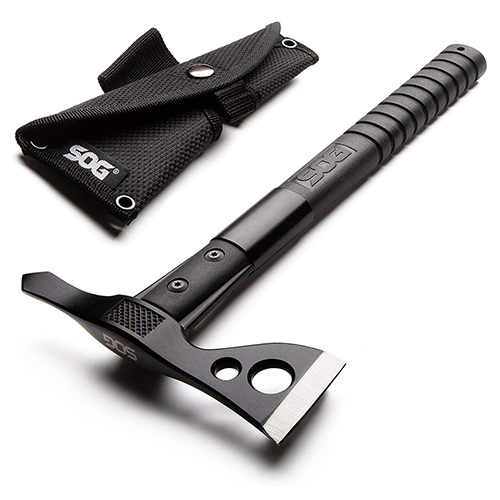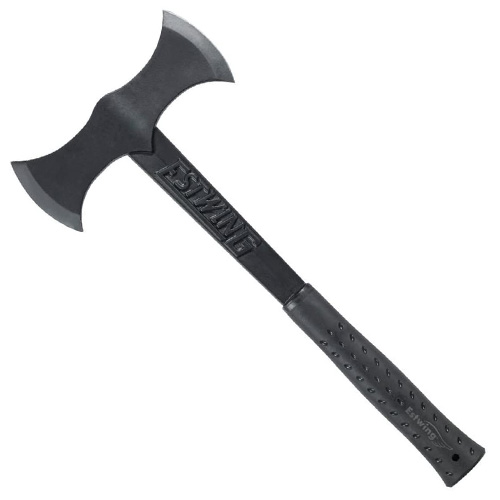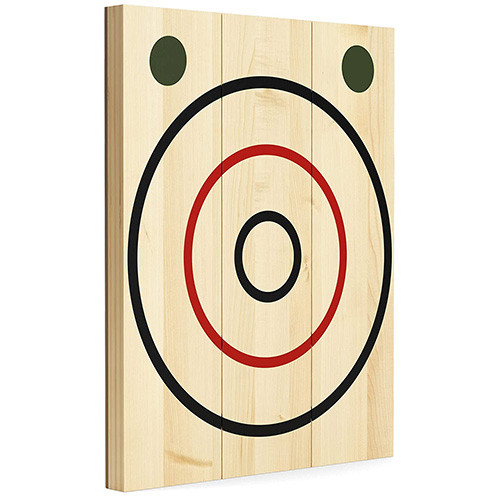Do you want to learn how to throw an axe? Have you been to an axe-throwing place lately and want to do it at home? Are you inspired to compete in professional axe throwing?
Long ago, axes were only thrown in war. Today, it’s becoming an increasingly popular sport that men and women all over North America are dying to try. If you have a decent-sized backyard and the right axe and target, you can learn to throw an axe yourself, just like one of those professional lumberjacks.
But, before getting to that level, you’ll have to start with the basics first. Keep reading to learn how to throw an axe like a pro lumberjack in three simple steps!

Choosing The Right Axe For Throwing
Throwing axes are much smaller and lighter than the typical axe. They’re around 14-16 inches long and range in weight from 1.5 lbs up to 4 pounds. Many throwing axes are also double-sided so that they have a better chance of hitting the target.
To start, you should choose the heavier axe, so that you can learn to throw with precision. Then, you can move ahead to the lighter axe. The throwing axes that are recognized by the World Axe Throwing League (WATL) are subcategorized as throwing axes, hatchets, and tomahawks.
It’s easy to think that throwing hatchets and camping hatchets are the same, but they are. Not only are throwing axe blades thinner, but they’re also shorter in length. Normal hatchets are made for cutting wood, so they are heavier and thicker to be able to stand all that pressure.
Best Throwing Axess Recommended By The WATL
There are so many models of throwing axes to choose from, but they are not all equal. And, if you plan to compete then you will want an axe that won’t get you disqualified. In light of that, here are some recommendations..
Throwing Tomahawks
Tomahawks like the SOG Fasthawk have shorter blades than normal axes. They’re lighter and razor-sharp to hit the target and stay there. They are usually around 14-16 inches, and the blade is around 3 inches long. Tomahawks are very lightweight, only weighing in at 1.5 to 1.7 pounds.
SOG FastHawk

Features:
- Light yet heavy-duty, the FastHawk explodes with power in every swing or throw
- Built for tactical use, you can rely on this axe to survive barbecues and the backcountry
- High-impact glass-reinforced nylon gives you a solid grip with zero maintenance
Throwing Hatchets
Throwing hatchets, like the WATL’s brand of competitive throwing axes, are slightly larger, with a much longer and broader blade, resembling that of a regular axe. These are a bit shorter, at 14 inches. But, unlike the Tomahawk, the hatchet has a longer blade of 4 inches.
WATL Competition Throwing Hatchet

Features:
- We are excited to announce the 2nd Generation, Competition Thrower Throwing Axe
- Ranging from 1.9-2.5lbs our perfectly balanced axe lineup will have you throwing for hours
- Our straight handles mean an easy release and more consistency
Throwing Axes
Throwing axes, like the Estwing Double Bit Axe have a thin blade and two axe heads instead of one so that there is a better chance of striking the target. These axes are also very lightweight and often have a steel or fiberglass handle, for a lighter axe weight and for better throwing.
Estwing Double Bit Axe

Features:
- Maximum strength and durability for a lifetime of hard work
- Perfect for chopping logs, small trees & branches or splitting firewood & kindling
- Includes ballistic nylon sheath to protect hand sharpened cutting edge
Setting Up Your Target
Now that you know what axe to get, the next thing you’ll need is an axe-throwing target. Make sure that you have a big area for this setup because you’ll need to stand at least 12 feet away from the target.
You can make your own target by building a board of planks and drawing a bullseye on it, but if you want a regulation axe-throwing target, choose the Viking Culture target or one from Bigshot Targets. You can learn more about scoring and guidelines at the WATL website.
Make sure that you’re practicing in a secluded area that has enough room for you, the target, and any ricochets that might happen. Hold your arms out and make sure that there is nothing in the way to affect your throw or to get in the axe’s way.
Viking Culture Axe Throwing Target

Features:
- Heavy Duty Pine Wood Target
- Hanging Chain Hardware Installed
- For All Styles of Axes, Hatchets, Knives

How To Throw An Axe Like A Pro
Throwing an axe can be fun, and actually quite liberating, as long as it’s been done properly. There are even televised events and national championships for it. And, luckily, it’s easy to learn how to throw an axe like a pro. Like every skill, all it takes is a little practice, and taking the right steps.
Step One: Your Axe-Throwing Stance
To get in the right axe-throwing position, you’ll need to line yourself up with the bullseye. Stand directly in front of it, around 12 to 15 feet away. These are the axe-throwing standards set by the WATL.
Place one foot back to stabilize yourself. If you’re throwing with one hand, your opposite foot should be the back foot. As you throw, you will bend your front knee, in a lunging position. However, don’t bend too low, or you will miss the target.
Step Two: Lining Up Your Throw
If you’re just learning how to throw an axe, you should start by you’ll want to throw an axe with two arms, not one. Holding the axe firmly, but not too tight, bring the axe up and behind your head. Then, bring it down to eye level and line the tip of the axe up with the center of the target.
For a more advanced axe thrower, throwing an axe with one hand means lining up the shot with the shoulder of the hand you’re throwing with. Bring your axe back beside your ear. Not too close, but at that distance. Then, bring your axe down, extend your arm, and line the tip of the axe up with the bullseye.
Step Three: Making Adjustments
You may need to adjust your position, depending on how many times your axe rotates before hitting the target. After lining up your shot and taking a few practice throws, you’ll know the right spot to stand in. If your axe hits the board handle first, you should take a tiny step back to give the axe more room.
If the top of the axe or top corner of the blade is the only thing that touches the board, step forward. You’ll know you’re in the right spot if the axe hits the board with the whole blade. It might be useful to draw a line in this spot, to remember it later.
Conclusion
Throwing axes have become very popular in North America as a recreational sport and even in professional sporting events. When proper measures are taken, it’s not as dangerous as it may seem, but it does take a lot of practice to get good at.
It might be tempting to show off your throwing skills when amongst friends, but it’s still a weapon that should be used with all safety measures put into place. So, if you do have spectators, make sure they’re standing a good distance behind you to stay safe.
If you have the right axe, a good target, and the patience to achieve a perfected swing, you’ll be wielding an axe better than a Viking warrior!

